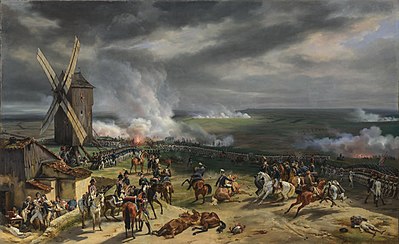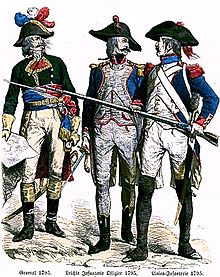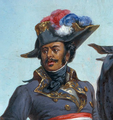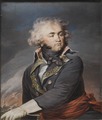French Revolutionary Army
| French Revolutionary Army | |
|---|---|
The French Revolutionary Army (
.As a general description of French military forces during this period, it should not be confused with the "revolutionary armies" (armées révolutionnaires) which were paramilitary forces set up during the Terror.[1] Following the proclamation of the French Empire in 1804 the Revolutionary Army became the Imperial Army.
Formation

As the
Almost all of the officers of the
Revolutionary fervour, along with calls to save the new regime, resulted in a large influx of enthusiastic, yet untrained and undisciplined, volunteers. These were the first
The transformation of the Army was most apparent in the officer corps. Before the revolution, 90% of the officers had been aristocrats, compared to only 3% in 1794. Revolutionary fervor was high, and was closely monitored by the Committee of Public Safety, which assigned Representatives on Mission to keep watch on the army generals. Indeed, during the war, some generals deserted, and others were removed or executed. The government demanded that soldiers be loyal to the government in Paris, not to their generals.[5]
1791 Reglement
Officially, the Revolutionary Armies were operating along the guidelines set down in the 1791 Reglement, a set of regulations created during the years before the Revolution. The 1791 Reglement laid down several complex tactical maneuvers, maneuvers which demanded well trained soldiers, officers and NCOs to perform correctly. The Revolutionary Army was lacking in all three of these areas, and as a result the early efforts to conform to the 1791 Reglement were met with disaster. The untrained troops could not perform the complex maneuvers required, unit cohesion was lost and defeat was ensured.
Realizing that the army was not capable of conforming with the 1791 Reglement, commanders began experimenting with formations which required less training to perform. Many eminent French military thinkers had been clamoring for change decades before. In the period following the humiliating performance of the French Army during the
In the 1770s, some commanders, among them the brilliant
Trial by fire

The French struck first, with an invasion of the Austrian Netherlands proposed by foreign minister Charles François Dumouriez. This invasion soon turned into a debacle when it was found that the hastily trained Revolutionary forces were badly disorganized and disobedient: on one occasion, troops murdered their general to avoid a battle; on another, troops insisted on putting their commander's orders to a vote. The Revolutionary forces retreated from the Austrian Netherlands in disarray.
In August 1792, a large Austro-Prussian army commanded by the
The Battle of Valmy ensured that the Revolutionary armies were respected and no longer underestimated by their enemies. For the next ten years, these armies not only defended the fledgling
Lazare Carnot
While the Cannonade of Valmy had saved the Republic from imminent destruction and caused its enemies to take pause, the
In early 1793, the
In early 1793 Lazare Carnot, a prominent mathematician, physicist, and delegate to the Convention, was promoted to the Committee of Public Safety. Displaying an exceptional talent for organization and for enforcing discipline, Carnot set about rearranging the disheveled Revolutionary Armies. Realizing that no amount of reforming and discipline was going to offset the massive numerical superiority enjoyed by France's enemies, Carnot ordered (24 February 1793 decree of the national Convention) each département to provide a quota of new recruits, a number totaling around 300,000. By mid-1793, the Revolutionary Army had increased around 645,000 men.
Levée en masse
On 23 August 1793, at Carnot's insistence, the Convention issued the following proclamation ordering a levée en masse
- "From this moment until such time as its enemies shall have been driven from the soil of the Republic all Frenchmen are in permanent requisition for the services of the armies. The young men shall fight; the married men shall forge arms and transport provisions; the women shall make tents and clothes and shall serve in the hospitals; the children shall turn linen into lint; the old men shall betake themselves to the public squares in order to arouse the courage of the warriors and preach hatred of kings and the unity of the Republic"[6]
All unmarried able bodied men aged between 18 and 25 were to report immediately for military service. Those married, as well as the remaining men, women and children, were to focus their efforts on arming and supplying the army.
This increased the size of the Revolutionary Armies dramatically, providing the armies in the field with the manpower to hold off the enemy attacks. Carnot was hailed by the government as the Organizer of Victory. By September 1794, the Revolutionary Army had 1,500,000 men under arms. Carnot's levée en masse had provided so much manpower that it was not necessary to repeat it again until 1797.
Tactics

Seeing the failure of the 1791 Reglement, several early revolutionary commanders followed de Broglie's example and experimented with the pre-revolutionary ideas, gradually adapting them until they discovered a system that worked. The final standard used by the early Revolutionary Armies consisted of the following:
- Troops with exceptional morale or skill became skirmishers, and were deployed in a screen in front of the Army. Their main fighting tactics were of a guerrilla-warfare nature. Both mounted and on foot, the large swarm of skirmishers would hide from enemies if possible, pepper their formations with fire and deploy ambushes. Unable to retaliate on the scattered skirmishers, the morale and unit cohesion of the better trained and equipped émigré and monarchist armies was gradually worn down. The incessant harassing fire usually resulted in a section of the enemy line wavering, and then the 'regular' formations of the Revolutionary Army would be sent into the attack.
- Troops with less skill and of more dubious quality, making up the 'regular' part of the army, were formed into battalion columns. The battalion column required little training to perfect, and provided commanders with potent "battering ram-style" formations with which to hit the enemy lines after the skirmishers had done their work. The skirmish screen also provided protection for those troops
Infantry

Following the dissolution of the Ancien régime, the system of named regiments was abandoned. Instead, the new army was formed into a series of numbered demi-brigades. Consisting of two or three battalions, these formations were designated demi-brigades in an attempt to avoid the feudal connotations of the term Regiment. In mid-1793, the Revolutionary Army officially comprised 196 infantry demi-brigades.
After the initial dismal performance of the Fédéré volunteer battalions, Carnot ordered that each demi-brigade was to consist of one regular (ex-Royal Army) and two fédéré battalions. These new formations, intended to combine the discipline and training of the old army with the enthusiasm of the new volunteers,[7] were proven successful at Valmy in September 1792. In 1794, the new demi-brigade was universally adopted.

The Revolutionary Army had been formed from a hodgepodge of different units, and as such did not have a uniform appearance. Veterans in their white uniforms and
Along with the problem of uniforms, many men of the Revolutionary Army lacked weapons and ammunition. Any weapons captured from the enemy were immediately absorbed into the ranks. After the Battle of Montenotte in 1796, 1,000 French soldiers who had been sent into battle unarmed were afterwards equipped with captured Austrian muskets. As a result, uniformity was also lacking in weapons.
Besides the regular demi-brigades, light infantry demi-brigades also existed. These formations were formed from soldiers who had shown skill in marksmanship, and were used for skirmishing in front of the main force. As with the line demi-brigades, the light demi-brigades lacked uniformity in either weapons or equipment.
Artillery
Supporting the skirmishers was the French
Cavalry

The cavalry was seriously affected by the Revolution. The majority of officers had been of aristocratic birth and had fled France during the final stages of the monarchy or to avoid the subsequent Terror. Many French cavalrymen joined the émigré army of the Prince du Condé. Two entire regiments, the Hussards du Saxe and the 15éme Cavalerie (Royal Allemande) defected to the Austrians.
Lacking not only trained officers, but also mounts and equipment, the Revolutionary Cavalry became the worst equipped arm of the Revolutionary Army. By mid-1793, the paper organisation of the Revolutionary Army included twenty six heavy cavalry regiments, two regiments of carabiniers, twenty dragoon regiments, eighteen regiments of chasseurs à cheval and ten hussar regiments. In reality, it was seldom that any of these regiments reached even half strength. However, unlike the infantry, where all battalions of the old Royal Army were merged with freshly raised volunteers to form new demi-brigades, the cavalry retained their regimental identities throughout the revolutionary and Napoleonic periods. As one example, the Regiment de Chasseurs d'Alsace (raised in 1651) was renamed the 1er Regiment de Chasseurs in 1791 but otherwise remained unchanged until it was finally disbanded after Waterloo.[8]
Aerostatic corps
The French Aerostatic Corps (compagnie d'aérostiers) was the first French
Notable generals and commanders
-
Napoleon Bonaparte
-
Pierre Augereau
-
Jean-Baptiste Bernadotte
-
Louis Charles Antoine Desaix
-
François Christophe Kellermann
-
Jean Baptiste Kléber
-
Étienne-Jacques MacDonald
-
Charles Pichegru
Notable battles and campaigns
Active Armies, 1792–1804
- Armies of 1792
- Armée du Nord
- Armée du Rhin
- Armée des Alpes
- Armée des Pyrénées
- Armée des côtes
- Armée du Centre
- Armée de réserve
- Armée du Var
- Armies after restructure of 1793
- Armée du Nord
- Armée des Ardennes
- Armée de Moselle
- Armée du Rhin
- Armée des Alpes
- Armée d'Italie
- Armée des côtes de Brest
- Armée des côtes de Cherbourg
- Armée des côtes de La Rochelle
- Armée des Pyrénées occidentales
- armée des Pyrénées orientales
On 1 October, the Armée de la Rochelle was redesignated as the
- Armies formed for specific tasks
- Army of Sambre-et-Meuse
- Armée de Rhin-et-Moselle
- Armée de RomeFormed from the Army d'Italie for the occupation of Rome.
- Armée d'Orientand divided into
- Armée de Syrie
- Armée d'Égypte
- Saint-Domingue expedition
- Armée de Réserve Formed in secret by Napoleon and led by him personally during the Italian campaign of 1800, culminating in the Battle of Marengo.
- Armée d'Allemagne
- Armée du Danube
- Armée de Hollande
- Armée des Grisons
- La Grande Armée.
See also
- Émigré armies of the French Revolutionary WarsRoyalist French forces in opposition to the revolutionary government of France.
- Social background of officers and other ranks in the French Army, 1750–1815
References
- ISBN 0300040423.
- ISBN 0-330-48827-9
- ^ "Lazare Carnot : Organiser of Victory : French revolution : Napoleonic personalities".
- ^ "Napoleon: Man of Peace".
- ^ Robert A. Doughty and Ira D. Gruber, ed. Warfare in the Western World: volume 1: Military operations from 1600 to 1871 (1996) p 187
- ^ Hazen, C.D. - The French Revolution Vol II, pp 666
- ISBN 1-84176-660-7
- ISBN 0-85045-269-4
- ^ Jeremy Beadle and Ian Harrison, First, Lasts & Onlys: Military, p. 42
- ^ F. Stansbury Haydon, Military Ballooning During the Early Civil War, pp. 5–15[ISBN missing]
- ^ Charles Coulston Gillispie, Science and Polity in France: The Revolutionary and Napoleonic Years, pp. 372–373[ISBN missing]
Further reading
- Bertaud, Jean-Paul. The Army of the French Revolution: From Citizen-soldier to Instrument of Power (Princeton University Press, 1988)
- ISBN 0-02-523660-1; covers each battle
- Elting, John Robert. Swords Around the Throne: Napoleon's Grande Armée, 784 pages. 1997. ISBN 0-306-80757-2
- Forrest, Alan. Soldiers of the French Revolution (1989)
- Forrest, Alan. Conscripts and Deserters: The Army and French Society during Revolution and the Empire (1989) excerpt and text search
- Griffith, Paddy. The Art of War of Revolutionary France, 1789–1802 (1998) excerpt and text search
- Hazen, Charles Downer – The French Revolution (2 vol 1932) 948 pages. ASIN B00085AF0W
- Haythornthwaite, Philip J. Napoleon's Military Machine (1995) excerpt and text search
- Lynn, John A. The Bayonets of the Republic: Motivation and Tactics in the Army of Revolutionary France, 1791–94, (1984) 356 pages, ISBN 0-8133-2945-0
- ISBN 0-253-31076-8.
- Scott, Samuel F. "The Regeneration of the Line Army during the French Revolution." Journal of Modern History (1970) 42#3 pp 308–330. in JSTOR
- Scott, Samuel F. From Yorktown to Valmy: The Transformation of the French Army in an Age of Revolution (1998) online Archived 2016-04-15 at the Wayback Machine
- Skocpol, Theda. "Social revolutions and mass military mobilization." World Politics (1988) 40#2 pp 147–168.
Primary sources
- Royal, Republican, Imperial, a History of the French Army from 1792–1815: Vol 1 – Infantry – History of Line Infantry (1792–1815), Internal & Tactical Organization; Revolutionary National Guard, Volunteers Federes, & Compagnies Franches; and 1805 National Guard., Nafziger, George. 98 pages. (https://archive.today/20121220114621/http://home.fuse.net/nafziger/NAFNAP.HTM)
- Royal, Republican, Imperial, a History of the French Army from 1792–1815: Vol 2 – Infantry – National Guard after 1809; Garde de Paris, Gendarmerie, Police, & Colonial Regiments; Departmental Reserve Companies; and Infantry Uniforms., Nafziger, George. 104 pages. (https://archive.today/20121220114621/http://home.fuse.net/nafziger/NAFNAP.HTM)
- Royal, Republican, Imperial, a History of the French Army from 1792–1815: Vol 3 – Cavalry – Line, National Guard, Irregular, & Coastal Artillery, Artillery & Supply Train, and Balloon Companies., Nafziger, George. 127 pages.
- Royal, Republican, Imperial, a History of the French Army from 1792–1815: Vol 4 – Imperial Guard, Nafziger, George. 141 pages. (https://archive.today/20121220114621/http://home.fuse.net/nafziger/NAFNAP.HTM)




















